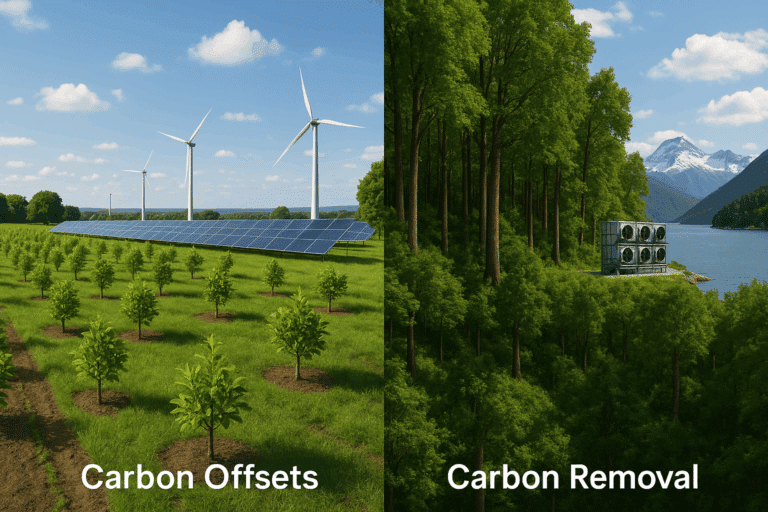As more businesses are realizing the urgency of sustainability, they are turning to carbon accounting software to manage and reduce their greenhouse gas (GHG) emissions. And you, as a business leader or a sustainability enthusiast, might be wondering: “How can I maximize efficiency and streamline my emissions reporting using such software?”
Stay tuned, as we embark on an enlightening journey to dissect, analyze, and ultimately help you choose the best carbon accounting software in the market today. 🌍
Why Carbon Accounting Software?
Before we delve into the specifics, let’s first address the question you might have: “Why do I need carbon accounting software?”
In essence, these software solutions provide an automated, efficient, and standardized approach to tracking, managing, and reporting your organization’s carbon emissions. They play a pivotal role in helping businesses meet their environmental targets, maintain regulatory compliance, and showcase their commitment to sustainability. With the right software, you can make your journey to net-zero emissions smoother and faster.🚀
Understanding the Role of Efficiency
Efficiency is a key aspect when choosing a carbon accounting software. An efficient software saves you time, effort, and resources, making your emissions reporting process as seamless as possible. This is precisely what we will be focusing on in this review: how to maximize efficiency when choosing and using carbon accounting software.
What to Expect in This Review
In the following sections, we will explore some of the best carbon accounting software options available. We will delve into their features, benefits, potential drawbacks, and pricing. We will also provide tips on how to select the software that best aligns with your specific business needs and objectives. Our goal is to provide you with an in-depth, unbiased, and comprehensive review that will enable you to make an informed decision. 💼
But that’s not all. To make this review as practical as possible, we will also share insights from industry experts and users, offering a first-hand perspective on the various software solutions.
Whether you are a small business owner looking for a user-friendly solution, a multinational corporation seeking to streamline its complex emissions reporting process, or an environmental consultant in need of a robust, feature-rich tool, there is something for everyone in this review.
So, are you ready to discover how to take control of your carbon emissions and make a positive impact on the environment? Get your notepad ready, make yourself comfortable, and let’s dive right in. This is your ultimate guide to maximizing efficiency with carbon accounting software! ⚙️
Unlocking the Power of Carbon Accounting Software
As an industry professional or an environmental enthusiast, you’ve probably heard about the concept of carbon accounting. But what does it entail? In simple terms, carbon accounting is the process of measuring the amount of carbon dioxide equivalents that an organization emits into the atmosphere as a result of its operations. The main goal of carbon accounting is to help organizations reduce their carbon footprint, thereby contributing to the global effort to mitigate climate change. Now, let’s dig deeper into the world of carbon accounting software and how it can revolutionize your emissions reporting.
Historically, carbon accounting was a labor-intensive and time-consuming process that required manual data collection and analysis. However, with the advent of advanced software solutions, businesses can now automate this process, improving accuracy and efficiency. Carbon accounting software not only simplifies data collection but also offers tools for data analysis, report generation, and scenario simulation. But with a plethora of options on the market, how do you choose the right software for your organization? Let’s delve into a comprehensive review of the top carbon accounting software to guide your decision-making process.
The criteria for this review include ease of use, data accuracy, report generation capabilities, and cost-effectiveness. We’ll also consider additional features such as integration capabilities with existing systems, level of customer support, and whether the software is backed by scientific research. Let’s take a closer look at the leading players in the carbon accounting software market.
Top Contenders in Carbon Accounting Software
It’s important to note that different software solutions cater to different needs and what works best for one organization may not necessarily be the best fit for another. However, by exploring the strengths and weaknesses of different solutions, we can provide you with a better understanding of what to expect from each software.
| Software | Strengths | Weaknesses |
|---|---|---|
| Carbon Analytics | Automated data collection, user-friendly interface, great customer support | Limited scenario simulation capabilities |
| Ecotrak | Comprehensive data analysis, extensive reporting features | Relatively high cost |
| Planetly | Excellent integration with existing systems, backed by scientific research | Requires initial setup and customization |
As you can see, each of these software solutions has its own unique strengths and weaknesses. For a detailed walkthrough of these software solutions, I recommend watching “Carbon Accounting Software Reviews” by TechReview on YouTube. This video does a great job of breaking down the features of each software and providing real-life examples of their applications.
Choosing the Right Carbon Accounting Software
Choosing the right carbon accounting software involves a careful evaluation of your organization’s specific needs and circumstances. Consider the complexity of your operations, the volume of data you need to process, and the level of detail required in your emissions reports. Also, take into account your budget constraints and the expertise of your team. You want to choose a software that not only meets your technical requirements but also aligns with your organizational culture and capabilities.
Additionally, it’s vital to consider the scalability of the software. As your organization grows and evolves, your carbon accounting needs will also change. Therefore, you need a software solution that can adapt to your changing needs. Furthermore, look for a software with robust customer support. This is especially important if your team lacks the technical expertise to troubleshoot potential issues.
Ultimately, the best carbon accounting software is one that helps you accurately and efficiently measure and report your carbon emissions, while also providing actionable insights to guide your sustainability efforts. So, take your time to explore different options, ask for demonstrations, and make use of trial periods to test the software before making a final decision.
Streamlining Your Emissions Reporting
One of the main benefits of using carbon accounting software is that it significantly streamlines the emissions reporting process. By automating data collection and analysis, these software solutions save you time and effort, allowing you to focus on what matters most – reducing your carbon emissions and working towards a more sustainable future.
Moreover, these software solutions provide you with a clear and detailed overview of your carbon emissions, identifying key areas of concern and suggesting possible solutions. This empowers you to make informed decisions and take proactive steps towards achieving your sustainability goals.
As a final tip, remember to regularly review and update your emissions data. This is crucial for maintaining the accuracy of your reports and ensuring that your sustainability efforts are on track. To learn more about how to streamline your emissions reporting, watch “Emissions Reporting Simplified” by GreenTech on YouTube.
Final Thoughts
Carbon accounting is a crucial component of any organization’s sustainability strategy. With the right software, you can automate and simplify this process, gaining accurate insights into your carbon emissions and making informed decisions to reduce your environmental impact. The journey towards sustainability may be complex, but with the right tools and resources, you can make significant strides towards your goals.
Remember, the key to successful carbon accounting is not just about choosing the right software but also about how effectively you use it. So, invest in training your team, establishing clear reporting procedures, and continuously monitoring your progress. With these steps, you’ll be well on your way to maximizing efficiency in your carbon accounting and reporting efforts.
As we navigate this path towards a more sustainable future, it’s essential to keep learning and adapting. I encourage you to continue researching, exploring different software options, and seeking expert advice. With time and dedication, we can collectively make a difference and contribute to the global effort against climate change.

Conclusion
In conclusion, we have embarked on a comprehensive journey of exploration, delving into the core of IT and engineering. We’ve unraveled the intricacies of these complex subjects, breaking them down into digestible, comprehensible pieces of information. Looking back at what we’ve covered, the depth and breadth of the knowledge we’ve shared is a testament to the captivating nature of these disciplines.
We started with an in-depth examination of Software Engineering, demystifying its essence, and diving deep into its principles, practices, and methodologies. Software Engineering, as we’ve learned, is not just about writing code. It’s a scientific and systematic approach to developing software, grounded in engineering principles. As software continues to permeate every aspect of our lives, the significance of software engineering cannot be overstated.
Equally important, we’ve looked at the pivotal role of IT in the modern world. Information Technology, as we’ve come to understand, is the bedrock upon which businesses and organizations build their digital infrastructures. The transformative power of IT extends beyond business, impacting every sphere of human endeavor. From healthcare to education, finance, and even agriculture, the application of IT is limitless. With the Bureau of Labor Statistics projecting a 12% growth in IT jobs over the next decade, the future of IT appears to be bright.
But, as we’ve discovered, understanding IT and Software Engineering is not a simple task. These are intricate subjects, requiring a solid grounding in computer science, mathematical concepts, and logic, among other areas. Thus, we’ve strived to present these concepts in a clear, understandable manner. We’ve distilled the technical jargon, translating it into language that anyone, irrespective of their technical proficiency, can understand. 😌
It’s my hope that this exploration has not only enlightened you but also sparked a deeper interest in these fascinating disciplines. I invite you to delve deeper, to continue your exploration beyond this article. Share what you’ve learned with others, and engage in vibrant discussions. More so, apply this knowledge in your everyday life or professional career.
Remember, as we’ve discovered, the application of IT and Software Engineering extends beyond the confines of a computer lab. These disciplines are shaping our world, transforming how we live, work, and interact. The knowledge you’ve gained here is not just for you—it’s for the world. 🌍
In the end, I want to emphasize the importance of continued learning. In the ever-evolving fields of IT and Software Engineering, staying updated is not an option—it’s a necessity. As the famous quote by Alvin Toffler goes, “The illiterate of the 21st century will not be those who cannot read and write, but those who cannot learn, unlearn, and relearn.”
I encourage you to keep exploring, keep learning, and keep sharing. After all, as we’ve learned, knowledge is power. 🧠
References:
ACM
Bureau of Labor Statistics
Thank you for embarking on this journey with me, and until our paths cross again, keep exploring, keep learning, and keep growing!



